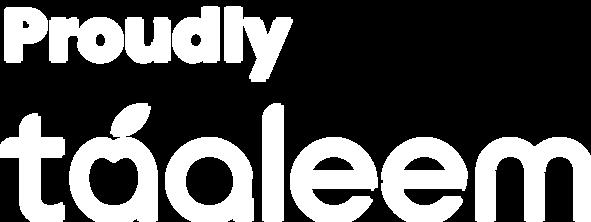CurriculumHandbook
EarlyYearsProgramme
KhalifaCityCampus




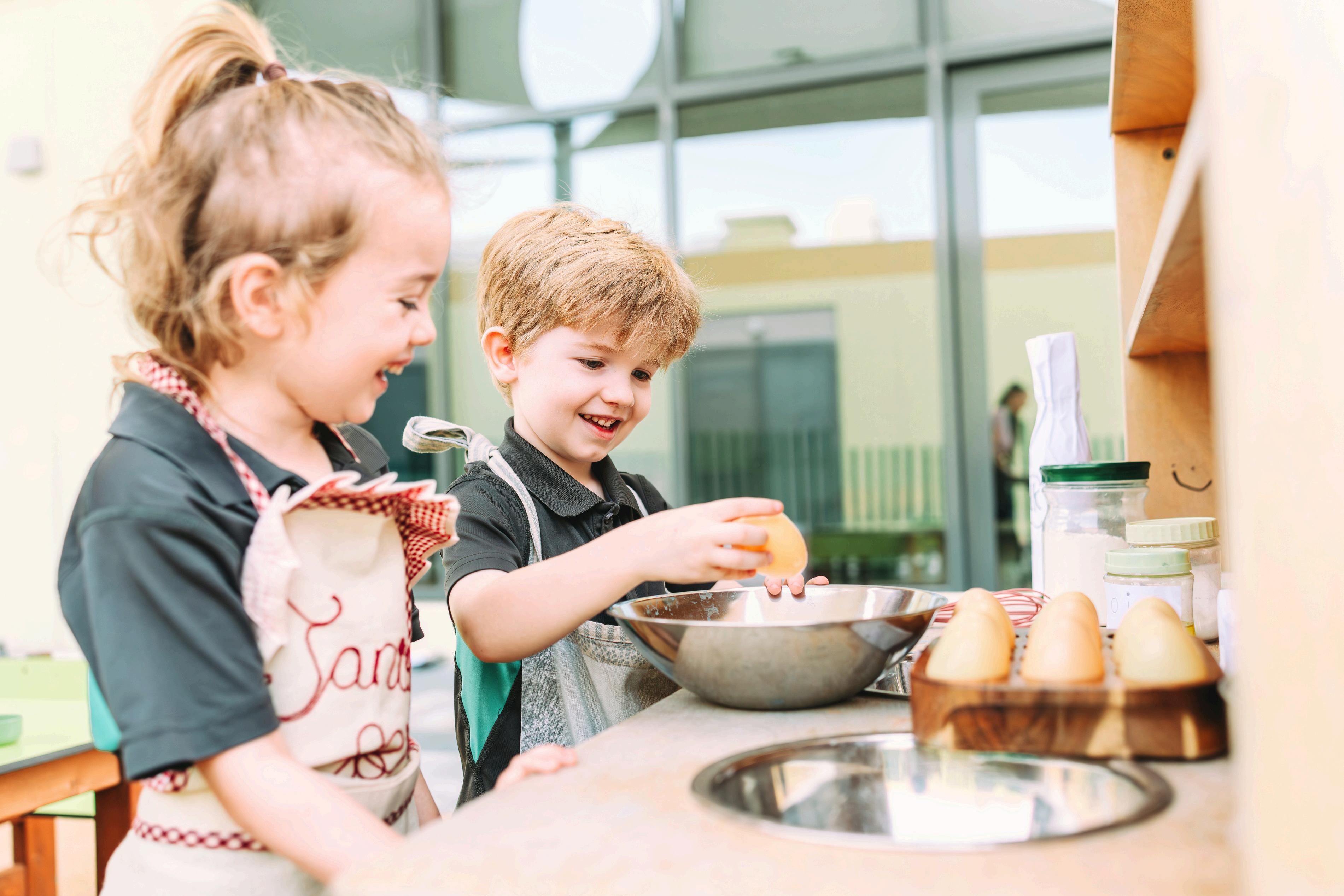
Khalifa City Campus Senior Leadership Team 2025 / 2026






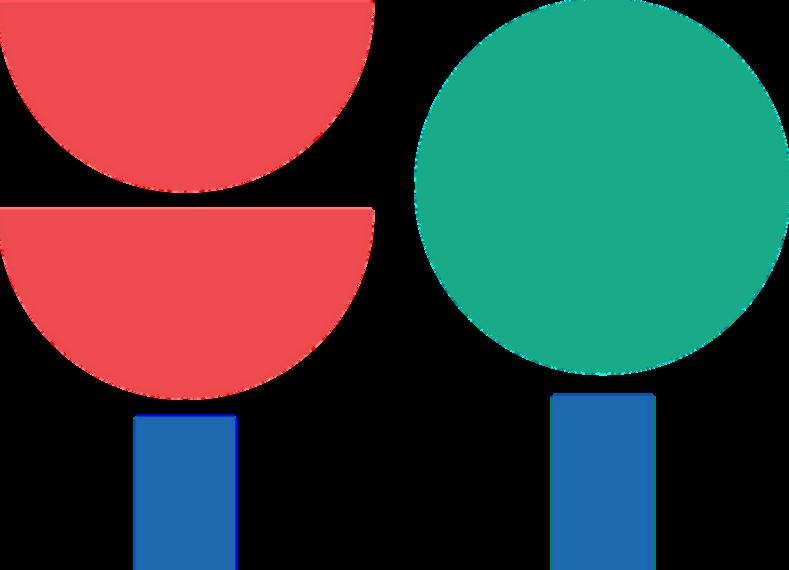


KhalifaCityCampus













At Khalifa City Campus (KCC) an Early Years education focuses on providing a hands on inquiry based curriculum that emphasses creativity independence and critical thnking These skills encourage students to become passionate about discovering new information and sharing ther ideas Our curriculumfocusesonthedevelopmentofstronginterpersona skillsandculturalunderstandings,which areessentialforsuccessinarapidlychangngglobalsociety
Each child is a unique learner and develops at varying rates, so in our EY classrooms, you wont find mass-produced, identical pieces of work Instead you will find children accessing hgh quality learning envronments designed to support a child-earning learning. Some children may be learning n the constructionarea whilstothersareinthewritingarea
Our adults immerse themselves in the students learning, playing the role of facilitator they play alongside, supporting and working collaboratively to ensure children move forwards in their learnng Skilfulquestioningsupportsstudents abiltytodevelopdeeplevelplay
At KCC we recognise that the environment plays a key role in supporting and extending a child’s learnng and development. Our use of high-quality continuous provson aongside well-planned adut drected activities is a highly effective approach to learning and teaching This careful balance of direct teachng and child-initiated learnng enables children to gain new skills and concepts and then to have an environment that allows them to practice, conso date and apply this new earning n a pedagogical appropriateway
Theclassroomsaresetuptoallowthechidrentoexploreandlearnsecurelyandsafely Weaimtocreate an attractive and stmulating learning environment where children feel confident secure and challenged Eachclasshasabaseclassroomwithadesignatedcarpetarea,allowingthewholeclasstogatherforkey timesthroughouttheday Theclassroomshaveanopenplanlayoutwithcontinuousaccesstotheoutside classroom Learning areas withn the classroom are clearly defined and equipment and resources are organisedsothatchildrencanfind locateandusethemindependently.
Signs labels and photographs are used to support the children in this process and provide a meaningful language rich environment. Children take ownership of their cassroom and contribute to the setting up and labelling of the spaces Classrooms have well-resourced and engaging writing readng and maths areas where the children lead their own learning by taking part in independent learning activities. We believe that the environment plays an important role in supporting learning and it is important to ensure thatthechildrenarenotoverstimulatedbytheenvironment
By using neutral colours for dispays, sensory overload s avoided and more focus is placed on the childrens work The children also have access to Hubs These are shared areas outside of the main classrooms that children access throughout the day. In these areas there is always a permanent ‘Home Corner that is enhanced across the year to reflect cultural events and ceebratons This alows children a familiarspacetolearnin oftenexploringandplayingwithnewlanguage
TheHomeCornerisawayscreatedtobeasrealisticaspossible withrea itemsusedwhereverpossible This is enhanced throughout the year according to the children’s needs and interests This might mean addingcookingequpmentandrecipebooksasthech drenbecomefascinatedwithcookng,oritmight meanaddngashoporaschoolclassroomsothatthechildrencantravelfromonetoanother.
Within The Hubs there is also an Art Studo which houses a variety of media options; pant transient art collageandworkshopresources Childrenaccessthisasindependentlyaspossibleandareencouraged towashuptheequipmentaftertheyhaveusedit
It is important that outdoor learnng encompasses the natura environment and that children are given opportunities to learn about our natural environment Opportunities for children to take risks should be providedwithintheenvironmentsothatchildrenare earningtomanagerisksandtheirsafety
Bycreatinganenablingenvironmentthatmeetsthesecriteria,educatorscansupportyoungchildren n theirholisticdevelopmentandsetthestageforasuccessfulandfulfillingeducationaljourney.
The National Identity Mark aims to heighten students understanding of the UAE’s traditions, customs and vaues,empoweringandenabingthemtonavigatethediversegoballandscapewithastrongfoundation based ntheirownculturalbackground
The framework covers three main domains each wth three relevant dimensions ‘Cuture’ includes history, heritage and Arabic language; which represents a key focus area within the framework; Values includes respect, compassion and global understanding; and ‘Ctizenship’ includes belonging volunteering and conservation
IntheEYatKCC,theNationalAnthemisplayedintheclassroomeachmornng AlstudentsfromMinis-EY2 learn Arabic As a school community, we celebrate UAE National Day, The Prophets Birthday as well as recognise and support al UAE holdays and celebrations We support our whole community durng RamadanandoneoftheyearlyhighlightsistheKCCcommunityiftar
Students make connections to and celebrate the UAE’s National Identty through the reated concepts outlined in the PO Teachers purposely plan learning experiences to help students to explore the UAE’s heritage history,values conservationefforts,traditions communty environmentandinterconnectedness
School trps are carefully chosen to make connections to our curriculum. Destinations and experiences are planned to enhance our children’s knowledge and deepen their understanding Trips n the Minis start with what children know and are familiar with; them, ther fam y, ther school They might include thingssuchasafamilypicnic atriptothePYPLibrarytoshareastoryoravisitfromthezoo
As our children move nto EY1 their understanding of the world around them grows and our school trips refectths withchildrenvisitingdestinationsinthelocalcommunitysuchastheparkandtheaquarium Trips n EY2 focus on expanding the students understanding of the wider local environment and include visitngplacessuchastheAbuDhabiLbraryandtheLouvre
AtKCC,ourpastora careliesattheheartofourcommitmenttoholisticeducation.Weunderstandthata thriving community is built on a foundation of mutual respect and shared values Through our emphasis on Community Expectations, we foster an inclusive environment where students, teachers and parents upholdacultureofempathy,understandingandsupport.
Behavours aligned wth these expectations are nurtured through positive reinforcement and restoratve practises, enabling students to grow into responsible individuals who contribute positively to their surroundings Recognising the Rights of the chid we empower each student with a voice ensuring their perspectivesarevaluedandtheirwellbengisprioritised.
Guided by our core values -knowledge, courage and connection- we shape our pastoral support initiatives. We equip students with the Knowledge to navgate challenges make nformed decisions and embrace continuous persona growth Courage is inst ed as we encourage students to express themselves authentically, face uncertainties with resilience and stand up for what is right Through fosterngConnection,wecreateasenseofbelongingthattranscendsdifferences
At KCC, pastoral care embodies these principes creating a nurturing space where every student is empoweredtothriveemotionally,sociallyandacademically
Wevalueallchildrenfeelingsafe,happyandsettledwhileatschool Usingrestorativepractceshelpsto encourage supportive and respectful behaviour We teach model and practice rules, procedures and expectations with children and help them understand why these exist. By usng postive reinforcement, our students fee motivated and respected which develops their self-confidence The wellbeing of our studentsandstaffisaprorty
Throughout the year various actvities and events are planned to enhance fun and wellbeing Support andcollaborationwithourschoolcounsellorallowsustoaddressanyindivdualconcernseffectively.We also use the GL PASS assessment to evaluate students’ wellbeing and identify areas that require attention Webe evethatfocusingonwellnessandbuildingstrongconnectonswithothersisneededto createapositiveenvironmentthatisimportantforgrowthanddevelopment.
Our students are taught to be open-minded and respectful communicators who think caringly about the impact of their behaviour on others When faced with choices in social situations they are expected to be principled and empathetc in their decision making and reflective when they could have made better decisions.
Purposeful modelling and positive reinforcement of the IB learner profle and attributes by all members of the school community encourages our students “to become active, compassionate and lifelong learners whounderstandthatotherpeople,withtherdifferences,canalsoberight”(IBO,2016)
Developing and reinforcing positive behaviour s an essentia responsbiity of our school community We recognize the importance of nurturing and guiding our students as they grow and develop to make approprate behavioural choices and to provide them with the required opportunities for reflection and counselwhenlessdesirablebehavioursoccur
At KCC we beleve our children have the right to protection, regardess of age, gender, race, culture or disabiity Theyhavearighttobesafeinourschool Protectingchildreniseveryonesresponsibiltyandthis incudesreportinganyact(commttedbyaparent guardianoranyotherperson)toachildenrolledinthe schoo whichresultsinneglect physicaloremotionalinjuryorsexua harm.
The International Baccalaureate (IB) was founded in 1968 and nitially offered the Diploma Programme, for 16 to 19 year olds to help them acquire the necessary skils and knowledge to ive, earn and work in a rapdlyglobalisingword By1997 theIBhadintroducedthePrimaryYearsProgramme(3to11years)andthe MiddleYearsProgramme(11to16years).
Today the IB works with over 5,00 schools in 148 countres and offers their programmes to over one million students At KCC we are proud to be one of these schools and offer both the Primary Years Programme (PYP) MiddleYearsProgramme(MYP)andwillsoonoffertheDiplomaProgramme(DP)
The KCC Eary Years sits within the PYP and offers a transdisciplinary framework for young students to be given authentic opportunities to focus on how to learn (skills) as well as ‘what’ to learn (knowledge) Studentsofallagesareencouragedtochalengeassumptionsandtobeactiveintheircommunitiesandto take their learning beyond academic studies in both loca and global contexts When we talk about transdisciplinarylearning,thismeanstheexploratonofarelevantconcept,issueorproblemthatintegrates the perspectives of mutiple disciplines n order to connect new knowledge and deeper understanding to reallifeexperences
TheIBnotonlyprioritisesacademcexcelencebutalsocultvatespersonalgrowth stmulatingstudentsto thinkcritically,exploreinterdisciplinaryconnectionsanddevelopaninquisitvemindset Embracingdiversity, fostering curiosity and nurturing a genuine passion for learning are fundamental values wthin an IB education KCCisacommuntyoflearnerswhereteachers parentsandstudentsarepartnersinlearning
Education for international-mindedness values the world as the broadest context for earning develops conceptual understanding across a range of subjects and offers opportunities to inquire act and reflect KCC and the IBO structure teaching and learnng with this in mind TheIB


ThinkoftheProgrammeofInquiry(PO)asaroadmap Thisroadmapprovidesaframeworkoflearning for our Minis through to our Grade 5 learners It provdes students with a range of opportunities to develop subject-specific knowledge as well skills and concepts and is designed around experences that encourage studentstobecomeactive compassonateandcuriouslearners
Each grade leve has its own road map that connect together with the grade before and after The POI is designedaroundbigtransdiciplinarythemescalled‘Untsof nquiry’
Whoweare
Whereweareinplace andtime
Howweexpressourselves
Aninquiryintothenatureofthesef;beiefsandvaues;persona physical mental socalandsprtualheath; humanrelatonshps ncudngfamles frends communtesandcultures rghtsandresponsiblties;whatit meanstobehuman
Aninquiryintoorentation npaceandtme persona histories;homesandjourneys;thedscoveres exporationsandmigrationsofhumanknd;thereationshipsbetweenandtheinterconnectednessof individualsandcviisatonsfromlocalandgoba perspectves
Aninquiryintotheways nwhchwediscoverandexpress deas eeings nature culture beiefsandvaues;the ways nwhichwerefecton extendandenjoyourcreatvity;ourappreciationo theaesthetc
Howtheworldworks
Howweorganise ourselves
Sharingthepanet
Aninquiryintothenaturalworldand ts aws;the nteractonbetweenthenatureworld(physical andbioogcal)andhumansoceties;howhumansusetherunderstandingofscientifcprncpes;the mpact ofscientifcandtechnologca advancesonsocetyandontheenvronment
Aninquiryintotheinterconnectednessofthehuman-madesystemsacommunties;thestrutter andfunctonoforgansations;societaldecsion-makng;economicactivitesandther mpactonhumanknd andtheenvironment
Aninquiryintorightsandresponsibltiesinthestruggetosharefiniteresourcesandotherpeople andwithother vngthngs;communitesandtherelatonshpswthinandbetweenthem accesstoequa opportunties;peaceandconfictresoution
Minis and EY1 srudents take part in four transdisciplinary units of inquiry, wh e those n EY2 take part in five Each unt has a Central Idea which is supported by three Lines of Inquiry These lines are studed through the lenses of key concepts, approaches to earning skills and learner profile attributes Teachers skillfully weave in subject specific learning content to create engaging and meaningful inquires. Throughout the unit the learning builds towards an Action Piece’ This is a piece of learnng that encapsulatesthelearningfromtheunit Thismightbeaposter afilm apieceofartworkorpresentation. Familiesareinvited ntoschooltoceebratethislearning
The Sustainable Development Goals (SDGs) are a set of 17 interlinked gobal goals desgned to be a "blueprint to achieve a better and more sustainable future for all" They were adopted by all Unted Nations Member States in 2015 as part of the 2030 Agenda for Sustainable Development These goas address a broad range of social economic, and environmenta challenges with the aim of ending poverty,protectingtheplanet,andensuringprosperityforallby2030 AtRahaKCC,wehaveincorporated and ntegrated these into our POI. By embracing these goals and taking action, our learners will truly developanunderstandingofbeingglobalcitizens

ThePYPidentifiessevenkeyconcepts Keyconceptsaretimeless,universalandabstract.Theyhelpstudents engage in creative and abstract thinking to deal with tricky ideas They are the big, organising ideas that arerevisitedtimeandtimeagain,hepingstudentsbuildlanguageandthinkngtoexplantheworldaround them TheysitattheheartofthePYPcurriculum.
Approachestolearningaregroundedinthebeliefthatlearninghowtolearnisfundamenta tobecominga lifelong learner Five categories of interrelated skills and associated sub-skills support students of all ages tobecomeself-regulatedlearners
Opportunities for ATL development are frequent in the KCC Early Years learnng environments Students develop a range of skills through support from adult-facilitated inquiries. For example a sensory walk throughthe ocalenvironmentorscienceexpermentmightprovidestudentswithachancetodemonstrate thinking skils (such as observing, finding unique characteristcs) and research skills (such as data gathering,recordingobservationsthroughdrawingortalying).
Function
Howdoesit work?
Causation Whyisitasit is?
Observing,identifying,describingandcategorising.
Theunderstandingthateverythinghasaformwithrecognisabefeatures thatcanbeobserved dentified describedandcategorised
Analysingthefunction,role behaviourandthewaysinwhichthings work
Theunderstandingthateverythinghasapurpose,aroleorawhatof behavingthatcanbeinvestigated
Promptingstudentstoask‘Why? andofhelpingthemtorecognisethat actionsandeventshavereasonsandconsequences
Theunderstandingthatthngsdonotjusthappen;therearecausal relatonshipsatworkandthatactionshaveconsequences
Change Howisit transforming?
Realisingthatwearegrowingupinaworldinwhichthepaceofchange, bothlocalandglobal,isaccelerating
Theunderstandingthatchangeistheprocessofmovementfromone stagetoanother Itisuniversalandinevitable
Connection
Perspective
Howisit linkedto otherthings?
Focusingontherelationshipswithinandamongsystemsareoften complexandthatchangesinoneaspectofasystemwillhave consequences,eventhoughthesemaynotbeimmediatelyapparent; thatwemustconsidertheimpactofouractionsonothers,whetherat theimmediate personallevelorattheleveloffar-reachingdecisions affectingenvironmentsandcommunities.
Theunderstandingthatweliveinaworldofinteractingsystemsinwhich theactionsofanyindivdualeementaffectothers
Whatarethe pointsof vew?
Helpingstudentsrejectsimplistic,biasedinterpretations,towards seekingandconsideringthepointsofviewofothersandtowards developingdefensibleinterpretations.
Theunderstandingthatknowledgeismoderatedbydifferentpointsof viewwhichleadtodifferentinterpretations,understandingsandfindings; perspectivesmaybeindividual group Culturalorsubject-specific
Through their self-initated play, students are able to develop communication skils (such as lstening, taking on pretend roles) and social skills (such as playing cooperatively helping others) as they nteract wth others Through engaging in physical activities they have the opportunity to develop selfmanagementskills(suchasdemonstratingperseverance,workingthroughsetbacks)
Critical-thinkingskills(Analysingandevaluatingissuesandideas)
Creative-thinkngskils(generatingnovelideasandconsideringnew perspectives)
Transferskils(usingskillsandknowledgeinmultiplecontexts)
Reflection/metacognitiveskills((re)consideringtheprocessoflearning)
Information-literacyskills(formulatingandplanning,datagatheringand recording,synthesisingandinterpreting,evaluatingandcommunicating)
ResearchSkills
Responsibility
Whatareour obligations?
Identifyingandassumingresponsibilityandtowardstakingsocially responsibleaction.Thisconceptisdirectlylinkedtotheaction component,oneoftheessentialelementsinthePYPcurriculum. Theunderstandingthatpeoplemakechoicesbasedontheir understandings,belevesandvaluesandtheactionstheytakeasaresult domakeadifference
Communication Skills
SocialSkills
Self-Management Skills
Media-literacyskils(interactingwithmediatouseandcreateideasand information)
Ethica useofmedia/nformation(understandingandapplyingsocialandethical technology)
Exchanging-informationskills(listening interpreting,speaking)
Literacyskills(reading,writingandusnglanguagetogatherandcommunicate information)
ICTskills(usingtechnoogytogather investigateandcommunicateinformaton)
Developingpositive nterpersonalrelationshipsandcollaborationskills(usng self-control managingsetbacks supportingpeers)
Developingsocial-emotionalintelligence
Organisationskills(managingtimeandtaskseffectively)
Statesofmind(mindfulness perseverance,emotionalmanagement,selfmotivation resilience
UnderpinningtheIBframeworkistheLearnerProfie.ThroughtheLearnerProfile,studentsareencouragedto become actve compassonate and lifelong learners who understand that other people, with their differences,canalsoberight Studentspractisedevelopingthesemindsetsandabilitiesindifferentcontexts astheyexploretheirunitsofinquiry.Studentsareexplicitlytaughttheskillsofbeingacaring globalcitizen. Asthestudents progressthroughthePYP,theygrowandreflectonallLearnerProfileAttributeswithanaim tobecomeaninternationallymindedglobalcitizen.(Apersonwhohasstrengthwithall10attributesissaid tobeinternationallyminded)
IntheEarlyYearsstudentsaregivenopportunitiestoconnectwthanddeveloptheLearnerProfleAttributes durngmeanngful,rea-lifeexperiences AkeywaythatteachersbringtheLearnerProfiletolifetoexemplify these through our students ceebrating when students demonstrate an attrbute Exampes of students embodyingthelearnerprofieattributesarealsocelebratedinEYassemblies.
Teachers also connect our community expectations to the earner profile attributes to deveop a set of classroomessentialagreements Co-createdwiththestudentsthesealignwithbehaviourexpectationswe expecttoseeasacommunityoflearners
Reading and storytelling make for rich opportunities to recognise the Learner Profile attributes Teachers often use stories to dscuss the attributes – pausing and asking questons about what attribute the charactersdisplayed.
Students as well as staff are encouraged to recognse and support these attributes with everyone in our community.Itistheresponsibilityofalmembersofthecommuntytomodeltheseattributes.

Thisisouryearlyreportingtimelne
At several points across the school year these learning stories and observatona assessments are formalised Familes are invited nto school at various points in the share to reflect celebrate and co construct learning goals to support their child The partnerships between home and school are integral to providing the foundation to support students’ learning growth, health and wellbeing and agency
After the first few weeks of school, parents are invited to meet with the students homeroom teacher for a settling-in meeting to discuss how the student has settled into their new grade level This meeting is focused mainly on the students welbeing as we believe that students cannot reach their ful potential if theydonotfeelsafe happyandengagedatschool
In November the student, teacher and parents have a three-way conference to discuss progress, skill development and set new goals Reflecting on progress and setting new goas s ntegral to students learning
In May parents attend a student-led conference These conferences are an opportunity for students to demonstrate some of the ways in which they earn, reflect on their progress and set new goals It provides insight for parents into the day-to-day life of the students as they lead their parents through hands-on activitiesandlearnngexperiences
Parents are provided with two written reports across the year, in February, at the end of semester 1 and in July,attheendofsemester2
We believe that parent-school partnerships are important to student success therefore, parents are encouraged to arrange a time to meet with the student’s teacher if they have any questions or concerns duringtheyear.
Languageisallaroundus.Itprovidestheabilitytocommunicateandtoinquireabouttheworld.Ch dren learn language by using language Our aim at KCC s to develop students ability to express themselves fluentlyandconfidentyinoral writtenandvisualcommunication
Language learning in the EY is integrated into all areas of learning and is organised into four strands: SpeakingandListening,ViewingandPresenting Reading,andWriting
Readingistaughtthroughacombinationofdirectteachingandsharedreading.Childrenalsoreadwiththe adultsintheirclass Thsstartsassharingstoriesorphonicflashcardsandwhentheyarereadymovesonto 1-1readingorgudedreading
Teachersconstantlymodelaloveofreadngthroughthehigh-qualitybookstheychoosetosharewiththe chidren Dailystorytimetakeplace,wheretheclasscometogethertoshareanddiscussastory Student's readinglevesareassessedand‘justright’booksaregiventothemforHomeLearning.Itis mportantthat students read every day as this consistency is important in their reading development and progress Children also take part n a daily phonics lesson which focuses on the correlation between written letters andthesoundtheserepresentanddecodingthis Duringthistimechildrenalsoworkonsightrecognition
Children learn to read by reading. In order to develop lifelong reading habits earners need to have extendedperiodsoftimetoreadforpleasure interestandinformation,experiencinganextensiverangeof qualityfictonandnon-fictiontexts Aslearnersengagewthinterestingandappealingtexts,appropriateto ther experiences and developmental phase, they acquire the skills, strategies and conceptual understandingnecessarytobecomecompetent,motivated independentreaders
Our Reading curriculum is organised into three strands: Concepts about print, Word recogniton, and Languagecomprehension
Arabic is celebrated as an important part of our curriculum We believe in the power of language to connect, enrich and shape young minds We aso value the importance of the Arabic language to our learners living in the Unted Arab Emirates Through engaging activities we create a vibrant space where children learn and become immersed in the Arabic anguage. Our teachers aim to foster a natural and enjoyablelanguageacquisitonprocess Storytelling songsandgamesarewovenintoourprogrammeto spark curiosity and nurturing a deep appreciation for Arabic. By embracing Arabic in our Early Years, we lay the foundation for cutura understanding and open doors to a world of diverse perspectives This commitment reflects our belief in fostering global citizens who value and embrace anguages as bridges togreaterunderstanding.
InthePYPEarlyYearsprogrammemathematicsisanintegralpartofourcurriculum Wevaluemathematics asapowerfultoolforunderstandingthewordandwefosterthisappreciationthroughabalancedblendof inquiry and focused teaching methods Our teachers gude students in exporing mathematical concepts within real-world contexts, encouraging them to ask questions and seek solutions Through purposeful inquiry, our Early Years learners delve into mathematical concepts that spark their curiosity nurturing a deep understandng that goes beyond rote memorisation We believe in fostering a growth mndset, cultivatingaloveforproblem-solvingandcriticalthinking Frominteractivemathareastoengaginggames and hands-on activties we create an environment where mathematical exploraton becomes a natural partofdailylife Thisapproachhelpsouryounglearnersdevelopastrongnumbersense,spatialawareness andtheabiitytoapplymathematicalthinkingindiversesituations
In the PYP science is viewed as the exploration of the biologcal, chemical and physcal aspects of the natural world and the relationships between them Our understandng of science is constantly changng andevolving Itencouragescuriosityandingenuityandenabesthestudenttodevelopanunderstandng oftheworld.
Reflection on scientifc knowedge also helps students to develop a sense of responsibility regarding the impact of their actions on themseves others and their world. Inquiry s central to scientific investigation and understanding Students actively construct and challenge their understanding of the world around them by combining scientific knowledge with reasoning and thinking skills. Scientific knowledge is made relevant through its innumerable applicatons n the real world The science process, by encouragng hands-onexperienceandinquiry,enablestheindividualtomakeinformedandresponsbledecisions not only nsciencebutalsoinotherareasoflife
In EY students work scientifically to explore scientific concepts within the earnng envronment Science is taught n a transdsciplinary manner, as part of the unit of inquiry learning environment and as standalone unts The science curriculum is separated into scence skills and science knowledge The studentsmakeconnectons ntheirlearningthroughhands-onactivitesandexperiments
Personal Social and Physical Education (PSPE) in the IB Primary Years Programme is concerned with the individuals wellbeing through the promotion and development of concepts, knowledge attitudes and skills that contribute to this wellbeing Wellbeing is intrinsically linked to all aspects of a student’s experience at schoo and beyond. It encompasses physical, emotional, cogntive, spiritua and social heath and development and contributes to an understanding of self to developing and maintaining relationshipswithothersandtoparticipationinanactive healthylifestyle.
The Arts are an integral part to the IB Primary Years Programme and includes Visual Art and Music Theyareapowerfulmodeofcommuncationthroughwhichstudentsexploreandconstructasenseof self and develop an understanding of the world around them Arts provide students with a wide range of opportunities and means to respond to their experiences and engage wth historica social and culturalperspectives.Thestudentsarestimulatedtothinkandtoarticulatetheirthoughtsinnewways andthroughavarietyofmediaandtechnologies
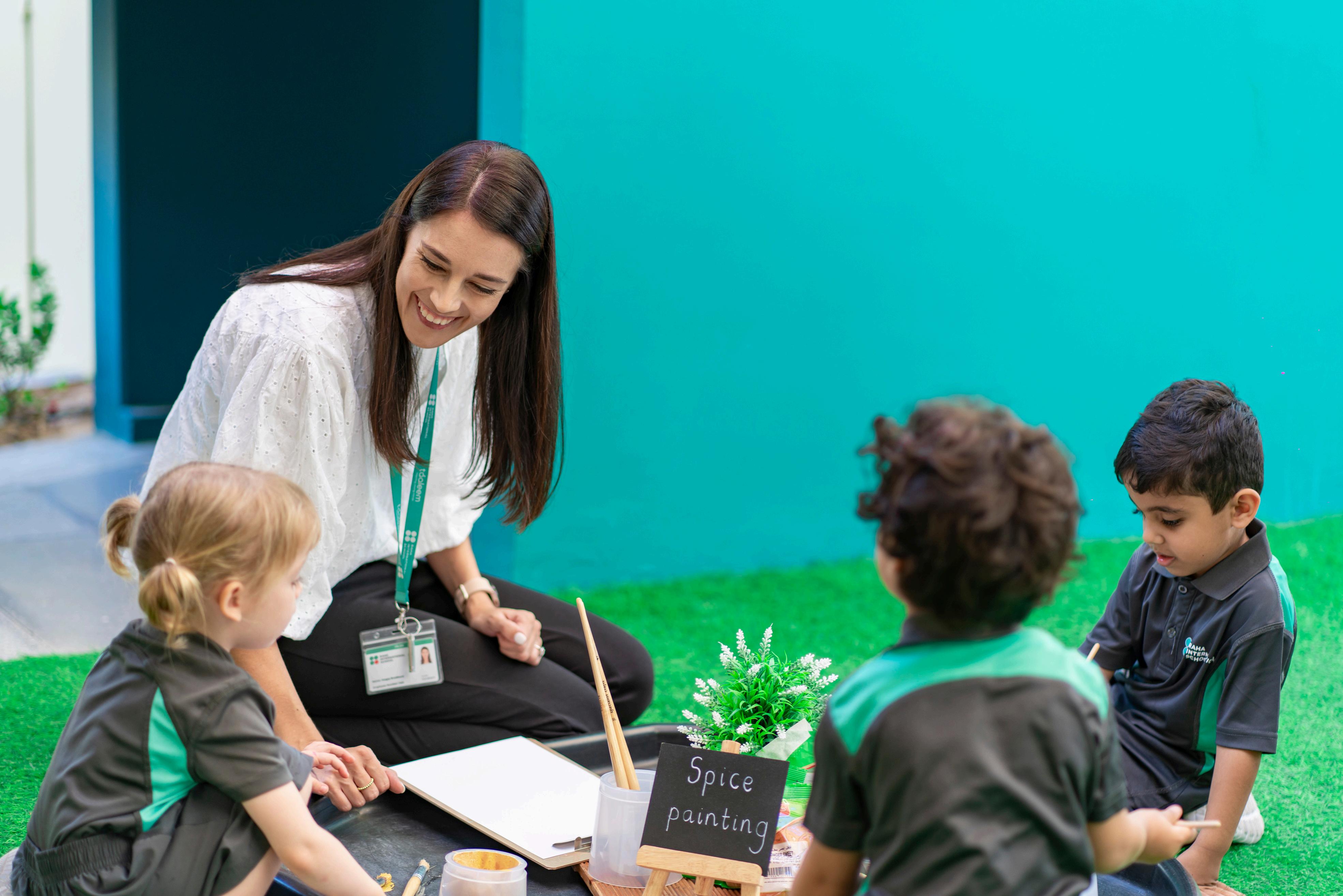
Overthenextsectionofthisdocument youwillfindtheCurriculumfortheEarlyYears Thisstartswththe ProgrammeofInquiry,whchdetailsthebigideasandgivesanoverviewoflearningacrosstheyear This then moves onto the Approaches to Learning, which maps out the learning skills that wil be covered n eachgrade.ThelastsectionistheCurriculumProgresssion.Thisisorganisedintoindivdualsubjectsand brokendownbygradelevel
Minis
Transdisciplinary Theme
Aninquiryintoidentityas ndivdualsandaspartofa collectivethrough:
Physca,emotonal socialandspiritualhealthand wel-being
Relationshipsandbelongng
Learningandgrowing
Familyisanimportantpartofwhoweare
CentralIdea
ConceptualLens
LinesofInquiry
Specified Concepts
Additional concepts
NationalIdentity
Meandmyfamly(form)
Simlartiesanddfferencesofwherewecomefrom (connection)
Responsibiitieswithinthefamly(responsbilty)
Aninquryintothedversityofvoce,perspectives,and expressionthrough nspration, magination creativity
Persona,socialandculturalmodesandpractces ofcommunicaton ntentions perceptions interpretationsand responses
Curiosityleadstodiscovery,expressionand creatvity
Aninquiryintounderstandingsoftheworldandphenomena through:
Patterns cyces,systems
Diversepractices,methodsandtools
Discovery design innovation possibiitesand mpacts
Aninquiryintotheinterdependenceofhumanand naturalworldsthrough: Rghts responsibilitiesanddignityofal
Pathwaystojust,peacefulandreimaginedfutures Nature,compexity coexstenceandwisdom
Typesofcreativity(form)
Communcatingthroughcuriosity(perspective) maginativeuseofmaterials(connection)
Form,Connection,Responsbilty Form Perspective,Connection
Weuseoursensestoexploreandwonderaboutthe world
Livingthingshaveneeds nordertogrow
Sustainability Goals
Simlarties differences behaviour,reationships, emotions friends,choices, ndependence empathy
Culture(history,heritage family)Values(respect)
(R)Famly ()ManagngSelf
Social(socialandemotonalintelligence, interpersonalreatonships)
Culture(hertage Arabiclanguage)
(P)StayingActve (E)Emotiona Awareness (E)Emotiona Management
Communcation(exchanginginformaton lteracy) Self-management(organsation,statesofmnd)
Oursenses(form)
Useofoursenses(function)
Worldwthoutsenses(perspectve)
Form,Function Perspective
Livingandnon-lvingthngs(form)
Needsoflivingthings(function) Howwecareforlivingthings(responsibiity)
Form,Function,Responsbility
Communcator,Risk-taker,Open-minded

Ctizenship(conservaton)
(P)Safety (E)Empathy
Sef-management(organisation statesofmind)
Values(respect,environment) Citizenship(conservation responsibiity)
(R)Ctizenship (S)Decsion-makng
Thnkngskils(Creative&critica) Communicatonskils(sharng nformation) Self-managementskils(managingsef)
Balanced, Principled, Caring
Aninquiryintoidentityas ndivdualsandaspartof acolectvethrough:
Aninquiryintothediversityofvoice,perspectves, andexpressionthrough:
Aninquryintounderstandingsoftheworldandphenomena through:
Aninquryintotheinterdependenceofhumanandnatural worldsthrough:
Transdisciplinary Theme
CentralIdea
ConceptualLens
LinesofInquiry
Physca,emotonal socia andspiritualhealth andwel-being
Relationshipsandbelongng
Learningandgrowing
Relationshipsandchoicesshapecommunity
Buildngcommunity
Buildngreationships(form)
Beingpartofacommunity(Responsbility)
Howouractionsaffectothers(Causation)
Form,Responsibility,Causaton
Specified Concepts
Additional Concepts Identity Culture,Groups
NationalIdentity
SEL
Transdisciplinary Links
Culture(Arabc anguage,heritage) Vaues (compassion) Ctizenship(belonging)
(R)Citizenship (R)Reationships (R)Fairness
Communicaton(exchangng nformation), Thnkng(analyss,evauation)
Inspraton, magination creativity
Personal socialandcuturalmodesand practicesofcommunication
Intentions perceptions interpretationsand responses
Imagnationsupportsexpressontoshare deas
Patterns,cycles,systems
Diversepractices,methodsandtools
Discovery,desgn innovation possibilitiesandimpacts
Exporationdrivesinnovationtoadapttothe environment
Weexpressideasandfeelngscreatively(Form)
Differentpeope magineandexpressideas differently(Perspective)
Theroleofimagnationinexpression (Functon)
Form,Perspective Functon
Engineering Properties Materials Innovation
Culture(hstory engineering)Ctizenship (innovation)
(E)EmotionalReguation (E)Resilience (I)Mindfulness
Howpeoperespondtochalengesthroughproblem solving(Change)
The mpactofexporationandinnovatonon communitiesandenvronments(Causation)
Usingthecreatveprocesstosolveproblems(Function)
Change,Causation Functon
Materials,Propertes,Innovaton
Citzenship(nnovation,sustainabiity)
(S)ReflectonandGoalSetting (S)Decison-making
Thinking(crticalandcreativethnkng reflecton) Thinking(anaysis applicaton,reflection),Research (informatonliteracy)
Rights responsibiitiesanddgntyofal
Pathwaystojust peacefulandreimaginedfutures Nature complexity,coexistenceandwisdom
Humanssharetheworldwthlivingthings
nquirer
Livngthings nourenvironment(connection)
Howouractionsmakeadfference(perspective) Wayswecanberesponsbleinourcommunity (responsbilty)
Connection,Perspectve Responsibiity
Care,Action,Envronment
Values(respect compasson,goba understandng) Citzenship(volunteering,conservation,survival)
(P)Stayingactve (P)MotvationforHealthyLiving (E)Empathy
Research(information iteracy),Socal(interpersona relationships)
Transdisciplinary
Theme
CentralIdea
ConceptualLens
An nquiry ntoidentityas ndivduasandas partofacollectivethrough
Physica,emotonal,socia andspiritual healthandwell-being
Relationshipsandbelongng
Learningandgrowing
Differenceshelppeopletoconnectand developacommunity
Aninquiryintothediversityofvoce, perspectives,andexpressonthrough nspiration,imagination creativty Personal,socia andcultura modesand practicesofcommunication ntentions perceptions interpretationsand responses
Peopeusedesignandinnovationtosolve problems
Aninquiryintounderstandingsoftheworldand phenomenathrough: Patterns cyces systems
Diversepractices methodsandtoos Discovery design innovation:possibiities andimpacts
Patternsandcyclesinthenaturalword helpusunderstandhowlivngthingsgrow andsurvive
Interactonswithinandbetweensocaland ecologicalsystems; Approachestolivelihoodsandtrade practices:intendedandunintended consequences
Representation,collaborationand decision-makng
Peoplecontrbutetotheircommunites indifferentwaystosupportwell-being andsustainability
An nquiry ntotheinterdependenceof humanandnaturalworldsthrough: Rghts,responsibilitiesanddignityofall Pathwaystojust,peacefuland reimaginedfutures
Nature,complexity coexistenceand wisdom
Livingthingshavefeaturesthathep themsurvive,andhumanshavea responsibilitytoprotectthem
LinesofInquiry
Featuresofour dentty heritage,and culture(form)
Wayswebelongtoandparticipatein differentcommunities(connecton)
Howweshowpride nourheritageand uniqueness(perspective)
Specified Concepts
Reasonspeopledesignandcreate(form)
Choosngtoolsandmateralsforapurpose (function)
Waysdesignsare nterpretedand mproved(perspective)
Patternsandcyclesinnature(Form)
Howseasonalchangesaffect ivingthings (Causation)
Howlivingthingsareconnectedthrough thenatura world(Connecton)
Differenttypesofrolesandprofessons inacommunty(form)
Howpeopeprepareandtake responsibiity ntheirroles(function)
Waysprofessionssupportcommunity well-beingandsustainability (connecton)
How ivingthingsaresuitedtotheir environments(Form)
Howpeopleandanimasare connectedthroughcareandimpact (Responsibility)
Differentperspectivesabout protectinganimas(Perspective)
NationalIdentity
Culture(Arabc anguage,history, heritage, dentity,groups)Values (compassion)Citizenship(belongng)
(S)Identity (R)BehavioursinRelatonshps (R)SenseofBelongng
Communicaton(exchangng information)Thinking(crticalthnkng–anaysisandevauation)
Cuture(Arabiclanguage,history hertage tradtions)
(E)EmotionalAwareness (E)Resilence
Communication(exchanginginformaton, iteracy)
Values(globalunderstanding)Citizenshp (conservation interaction patterns)
(I)ManagingSelf
Thnkng(CriticalandCreative) Research(ObservingandRecording)
Culture(Arabiclanguage hertage) Citizenship(belongng community, volunteering)
(R)Family (S)Decison-Making
Socia (interpersonal) Sef-Management(managngsef)
Values(respect compassion global understanding)Ctizenship (conservation,connection)
(R)Ctizenship (S)ReflectionandGoalSetting
Research(InformationLiteracy) Social(InterpersonalRelationships)
Withsupport Icanobservecarefuly andmakeacomment
Withsupport Icanparticpatein discussionswithmypeersandteacher
Icanobservecarefullyand wth support mentionsomethngspecal aboutwhat observe
Icanparticipateindiscussonswithmy peersandteacher
Withsupport Icanfndatleastone simlarityordifferencebetweentwo ideas
Icanobservecarefullyandmenton somethingspecia aboutwhatI observe
Withsupport Icanparticpateingroup discussionsaboutideaswithmypeers andteacher Icanfindatleastonesimiarityor differencebetweentwo deas
Wthsupport Ican starttoorganse information
Wthsupport Ican organseinformation
Icanstarttonoticeif something strueor not
Withsupport Icansometimes expainthedecsions make
Icansometmesexplainthe decisonsImake
Icanstarttosayhowmy thinkinghaschanged Icanbegintosuggestsolutons tosmpleproblemsrelevantto me
Ican ndependently organseinformation IcansayifIthnk something strueor not
Iampractsing listeningtodirections and nstructions
Iampractsing listeningtoothers respectfuly
Icanlstenand respondtodrections and nstructions
Icanlstenactiveyand respectfuly
Icanaskfor carification
Icanlstenand respondtoinformaton
Icanlstenactiveyand respectfuly
Icanaskclarifying questonswhen necessary
Icantalkaboutthemeaningof symbos sgnsandsoundswith guidance
Iamlearnngtowatchpeope whiletheyspeakandshowthat am istenng
Iamlearnngtorecognise createandmakemeaningusng symbos sgnsandsounds
Iampractsingwatchngpeople carefullywhileIlistentothem andnoticnghowtheyarefeelng
Imakeuseofvisua,audio ora communcatontomake meanng
Icanusesymbols,signsand soundstoexpressideas
Icansometmesexplainthe decisonsImakebasedonwhatI know
Icansayhowmythinkinghas changedwhen getnew informatonandevidence Icansuggestsolutonstosmple probemsreevanttome
Iamlearningtospeakcearyto expressmyideas
Iambeginningtoshare deasand opinionsinbothsmal and arge groups
Itrytospeakclearlytoexpress deas sotheymakesensetoothers
Icanparticipateinconversations
Iamabetoshareideasandopinions inbothsmalland argegroups
Icanbranstorm deaswthteachers andpeerswithgudance
Icanexpressmyselfclearly usingwordsandsentences Icanshareideasandopinions nboth smalandlargegroups Icanbranstorm deaswthteachers andpeers
Wthsupport canstart tosuggestideasfor payandthngstodo
Icansuggestandwth support,sometimes improveideasforplay andthingstodo
Wthsupport canuse atleastone‘visble thnking’routine
Icansuggestand sometmesimprove ideasforplayand thngstodo Icanuseatleastone visibethinking routne
Iamlearnngtoformulate questionsaboutdifferent things
Withsupport Icanask whatif’ questions
Withsupport Iamstartngto thinkaboutdifferentsolutonsto problemswhenIampayngor doingsomethng
Icanask‘what f’questions Icanthnkaboutdfferent solutonstoproblemswhenI amplayingordongsomething
Withprompting andsupport,I ambeginnng tousethngs havelearnedin dfferent stuations
Iambegnning tousethngs havelearnedin dfferent stuations
Withprompting andsupport, ambeginnngto make connectons betweenuntsof inquiry
Iambeginning tomake connectons betweenuntsof inquiry
Withsupport,Icansayonething am goodatandonethingIwanttolearn
cansaywhatIamgoodatandwhat wantto earn
canreflectonmy earningbyaskng questionssuchas:WhatdidI earn today?WhatcanIalreadydo?What wil Iworkonnext?
canreflectonmy earningbyaskng questionssuchas:Have beena prncipledandcaringlearner?
I istentoavarietyoftextsfor entertainmentandinformatonwth support
Iambeginningtoanswerquestions aboutwhatwasreadtome
I istentoavarietyoftextsfor entertainmentandinformatonwth support
Iamlearningtoaskandanswer questionsaboutwhatIhaveread
Ireadavaretyoftextsfor entertainmentandinformatonwth support Iamlearningtoaskandanswer questionsaboutwhatIread Icandocumentobservationsand information navarietyofways Icancommuncateusngarange oftechnologiesandmaterals
Icantellsomeoneaboutastory lstenedto Icandiscusstherepresentatons create (drawng/lettters/words)Ihavecreated totelsomeonewhattheymean
Icandraw/writetosharemythinkingor expressmysef Icantellsomeonewhichthingswere interestng/mportant natextweread Icandiscusstherepresentatons create (drawng/letters/words) havecreated totelsomeonewhattheymean
Icanwrtetosharemythinkingor expressmysef Icantellsomeonewhichthingswere interestng/mportant natextweread Iambegnningtopanmywritingbefore Istartbydiscussingmyideas cango backandeditmywritingwithsupport
Iambengexposedtoprint anddigitalmedia
Iambengexposedtoboth printanddgita mediato find nformation
Wthanadult canlook backatmyworkonadgital patformandtalkabout whatIlearned
Iamstartngtouseboth printanddgita mediato find nformation
Whenusingmycassroom’s dgita patform make carefulchocesaboutthe wordsIuseandthe pctures/vdeosIshare
Iambeginningto experimentwthdfferent waystocommunicatewith others
IcanteladultsIworkwith thatIwouldliketosharemy workonadigitalplatform
Icanchoosebetween2 differentwaysto communcatemyideas withsomesupport Icanbegintodecide whethertoornotpostmy ideas/learnngonmy digitalaccount(school platformony)
Withsupport, begintoask questionstohepme understand
Withsupport, canbeginto choosewhichinformation anddigita toolsIneedto answeraqueston
Ibegntoaskquestionsto helpmeunderstand
Withsupport, canbeginto choosewhichinformation anddigita toolsIneedto answeraqueston
Ibegntoaskquestions aboutmyinquiryandmake connections
Icanbegintochoosewhich informationanddigitaltools
Ineedtoansweraquestion
Withmyteachershelp can folowtheinquirycyce
Withsupport Icanbegintofind information needfrom resourcesmyteacherprovides
Withsupport Icanstarttouse allmysensestonoticedetais
Withsupport Icanbegintofind information needfrom resourcesmyteacherprovides
Withsupport Icanstarttouse allmysensestonoticedetais
Withsupport Icanstartto recordobservationsthrough drawingorwriting
Icanbegntofindinformation needfromresourcesmyteacher provides Icanstarttouseallmysenses tonoticedetails
Icanstarttorecord observationsthroughdrawngor wrting
Withsupport Ican starttosortand categorise information
Withsupport Ican saysomethingabout the nformationIfind
Icanstarttosortand categorise information
Withsupport Ican saysomethingabout the nformationIfind
Icanfindtwopeces ofinformatonand say ftheyaresmlar ordifferent
Withsupport Ican saysomethingabout the nformationIfind
Wthsupport, canstarttonotice connectionsbetweenpiecesof information
Wthsupport, canstarttoshare information
Icanshareinformatonbytaking tomyteacher
Wthsupport, canstarttonotice connectionsbetweenpiecesof information
Wthsupport, canstarttoshare informationinmorethanone way
Wthsupport, canbegintotak abouthowIgotmy nformation
Wthsupport I cannoticefew connections betweenmedia resources
Withsupport Ican share nformation and deasusingat eastonemeda source
Wthsupport, can usemediafora specificpurpose
Wthsupport, can usemediatoshare deaswithothers
Icanstarttonoticeconnections betweenpecesofinformaton Icanstarttoshareinformationin morethanoneway IcanbegintotakabouthowI gotmyinformation cannotcefew connections betweenmedia resources canshare nformationand deasusingat eastonemeda source canusemediato shareideaswith others
Withsupport Iam partofaclassthat usesmediasafely andhonestly
Iampartofacass thatusesmeda safeyand honestly
Withsupport, amstartingto takepartin dscussions aboutwhether alinformaton onlneistruthfu
Icanfollowsmpledirections
Icanfollowmyclassroutne Icanchooseand completetasks
Icanfollowdrections
Icanfollowmyclassroutne
Icanchooseand completetasks
Icanfollowabalancedscheduleformyself Icangatherequpmentandtoolstosupportmy learning
Iamlearningto trackmytime Icantakeonandcompletetasksinagiventimeframe
Icandemonstrateresiiencewhenfacedwithachalenge Icanusestrategiesto solveprobemswththeteachers support
Iamlearningtopractcepersstencewhenmetwthabarrieror challenge
Iamlearningstrategies canusetoovercomechallengesor barriers nmylearning
Icanusestrategiesto resolveconflctwiththeteachers support
Iamlearningtopractcepersstencewhenmetwthabarrieror challenge
Iamlearningstrategies canusetoovercomechallengesor barriers nmylearning
Icanusestrategiesto resolveconflcts
Ican dentifyhow amfeeling Icantakecareofmyselfwiththesupportofanadult
Ican dentifyhow amfeeling
Icanmanagemyfeeingsandemotions
Icantakecareofmyselfwiththesupportofanadult
Icanexplainhow Iamfeeing Icantakecareofmyself
Icanmanagemyfeeingsandemotions
Withsupport canidentifythedfferencewhenImakeagood choicevsapoorchoce
Withsupport canidentifythedfferencewhenImakeagood choicevsapoorchoce
Withsupport canfollowrepetitiveroutines
canidentifythedfferencewhenImakeagoodchocevsa poorchoice canidentifythedfferencewhenImakeagoodchocevsa poorchoice canfollowrepetitiveroutines
cancamdownwhenIgetsadorangrywthmore ndependence canidentifythedfferencewhenImakeagoodchocevsa poorchoice canfollowclassroutines
canrecognisewhenIamhappy,sad ornervous canrecognisefeeingsinothers
canrecognisewhenIamhappy,sad ornervous canrecognisefeeingsinothers
can nteractcarnglywithothers cansharetheresourceswth support
canusecarngwords canrecognsethefeelngsofothers
Withsupport am beginningtohelpafriend
Icanshareandtaketurnswithguidance
Icanplaycooperatvelyinagroup
havedifferentfeelingsthatcan contro,withhep canrecognisefeeingsinothersand empathse
careforothersandtheirbeongings candisagreeandagreewth respectwiththesupportofthe teacher
ambegnningtohelp others
Icanshareandtaketurnswithguidance
Icanusewordstoexpressfeelngs needs andwantstootherswthgudance
Icanplaycooperatvelyinagroup
Icanshareandtaketurns
Icanusewordstoexpressfeelngs needs andwantstoothers
Iambeginnngtounderstandhowmy choicescanaffectothers
Wthsupport Iam beginningtotalkabouta problem
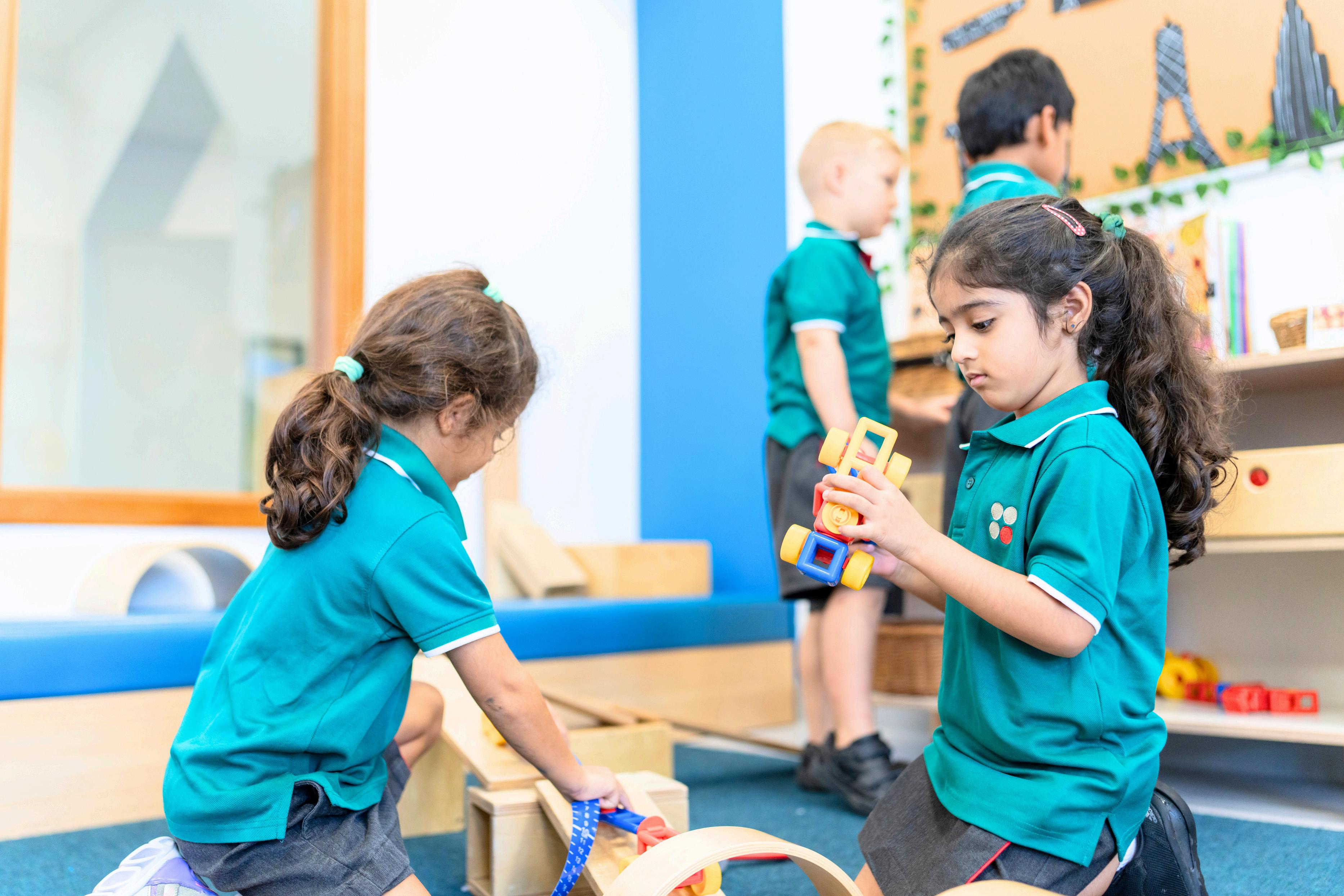
Talkaboutdrawings,modesandactions nsimpeterms
Retellaneventoranexperienceinsimpleterms
Usesentenceswithfiveormorewords(mayhavesome grammaticalimmaturtieseg leavngoutsomelinkingwords)
Usenewlylearnedvocabularyintheirplay
Speakclearlyenoughtobeunderstoodbyadultsandpeers
Understandandusesimpequestionstoestablishwhythings happenandtoclarifyunderstanding(e.g.Why?How?CanI?)
Engageinsoundandwordplay
Recognizerhythmandrhymeinspokenwordsandjoininwith rhythmicactivities
Listenandrespondwthgrowingattentionandconcentration
Listentoandcarryouttwostepinstructions
Hearanddiscriminategeneral environmenta soundsandspeech sounds
Followsimpleactionwords(eg ingamesandsongs)
Listenandjoininwithsongs,rhymesandstories
Retellastoryorinformationthattheyhaveheard,nsimpleterms AnswersimpleWho?,What?andopenendedquestionsrelatingto ownexperences storiesorevents
Askanappropriatequestionsaboutsomethingthathasbeensaid
Language-ViewingandPresenting
Attendtovisualinformationshowingunderstandingthroughplay gestures,facialexpression
Revealtheirownfeelingsinresponsetovisualpresentations,for example,byshowingamusement,curiosity,surprise
Usebodylanguagetocommunicateandtoconvey understanding forexample,pointing gesturing,facialexpressions
Recognisefamiiarsigns labelsandlogos forexampe,pedestran walkingsign,emergencyexitsign nodogsallowed;identify similaritiesanddifferences
Talkaboutthngstheyhavemade,ordone,addingsome description
Talkaboutthngsfromtherexperienceandshareinformation
Usewords phrasesandsimplesentences
Useappropriate increasingvocabulary ntheirplay
Speakaudibyconveyingmeaningtolistenersbeyondfriendship group
Useavarietyofquestionstoestablishwhythingshappenandto clarifyunderstanding(e.g.Who?What?Why?When?How?
Showanawarenessofalliteratonandrhyme
Recognzerhythminspokenwordsandcontinuearhymingstring
Showthattheyhavelistenedtoothers(e.g.bydrawingapcture)
Listentoandcarryoutthreestepinstructions
Isolateandidentifyinitia soundsinspokenword
Followactionwords/commandwords
Joinin,repeatormemoriserhymes,songsandstories(with support)
Retellnarrativesorinformationthattheyhaveheard AnswerWho?,What?,Where?andopenendedquestionsrelatingto ownexperiences,storiesorevents
Showunderstandingofwhattheyhaveheardbyaskingquestions tofindoutmoreinformation
Talkaboutthethingstheyhavemadeordone explainingtheprocess
Includesomedetai andsomerelevantvocabularytoextendtheir deasor accounts
Buildonpreviousexperence makingthemselvescearbyorganisingwhatthey sayandchoosingwordsdelberately
Useanincreasingrangeofappropriatevocabuaryinplayandstructured activities
Speakclearlytoarangeofaudiences
Useavarietyofquestionstoestablishwhythingshappenandtoclarify understanding(egWho?What?Why?When?How?)
Useallterationandrhymeinarangeofcontexts
Userhythmandrhymetocreatemoredetailedchants rhymesandpoems
Listentoothers,withgrowingattention usuallyrespondingappropriately(eg. carryingoutinstructions)
Listentoandcarryoutincreasinglycomplexinstructions
Isolateand dentifymedialvowelsandfinalsounds nspokenwords
Oralyblendandsegmentwords
Followmorecomplexactioncommands
Joininormemoriserhymessongs poemsandstories
Retelnarrativesorinformationthattheyhaveheardusingsmpleconnectives
AnswerWho?,What?,When?,Where?andopenendedquestionsrelatingtoown experiences storiesorevents
Showunderstandingofwhattheyhaveheardbyaskingrelevantquestionstofind outmorespecfic nformation
Makepersonalconnectionstovisualtexts,forexample apicture bookaboutchildrenmakngfriendsinanewsituation
Observevisualcuesthatindicatecontext;showunderstandingby matchingpictureswithcontext
Selectandincorporatecolours,shapes,symbolsandimagesinto visualpresentations
Showappreciatonofillustrationsinpicturebooksbyselectingand rereadngfamiliarbooks,focusingonfavouritepages
LocateanduseappropriateICTiconographytoactivatedifferent devices forexample,computergames,CDplayer television
Listentoterminologyassociatedwithvisualtextsandunderstand termssuchascolour shape,size
Attendtovisualinformationshowingunderstandingthroughdiscussion roleplay illustrations
Talkabouttheirownfeelingsinresponsetovisualmessages;showempathyfor thewayothersmightfeel
Makeconnectionstovisua textandtheirownexperiences
Usebodylanguageinmimeandroleplaytocommunicateideasandfeelings visually
Practiseanddevelophandwritingandpresentationsklls
RecogniseICTiconographyandfollowpromptstoaccessprogrammes
Becomeawareoftheuseandorganisationofvisualeffectstocreateaparticular impact forexample,dominantimagesshowwhatisimportantinastory
Observevsua magesandbegintoappreciateandbeabletoexpress thatthey havebeencreatedtoachieveparticularpurposes
Understandthatprintandillustrationsconveymeaning (print=symbols,logos letters,markings)
Understandthedifferencebetweenpicturesandwords andcandistinguishbetweenthem
Understandhowtohandlebooks(Holdsthebookupthe rightwayup,turningpagesonebyone)
Understandthatprintconveysmeaning
Understandthatauthorswritebooksandillustratorscreatethe pictures
Understandthatpeoplereadforpleasureandentertainment
Understandthattextscanbewrittenindifferentways(storiestellus aboutanimaginedworldsandinformationtellsusaboutthereal world)
Understandthepartsofabook(Frontcover,backcover,spine,title blurb,author,illustrator)
Understandwheretobeginreadingandwheretoend(InEnglish-left torightandtoptothebottom)
Understandthatsoundsarerepresentedbyletters
Recognisefamiliarwords(ownfirstname,logos screen icons)
Demonstrateanawarenessoftherelationshipbetween lettersandsounds
Noticerhymesandrepetitioninwhatisbeingreadto them
Linkpicturesorobjectswithspokeninitialsounds
Respondwiththesoundwhenshownthecorrespondingletterfor almostallofthephase2andsomeofthephase3graphemes
Readsimple(VCandCVC)decodablewordsbyblendingsounds together(it,on map,cat)
Readautomaticallyandfluentlyhighfrequencywords(almost allofthephase2HFW-notyetdecodable)
Readsimplephrasesorsentences(Usingphase2and3lettersand soundsthatincludesomeHFW)
Understandthatthewordsweseeandhearhelpustocreatepicturesin ourminds
Understandthatprintispermanentanddoesntchange
Understandthatwrittenlanguageworksdifferentlyfromspoken language
Understandthatusingconsistentwaysofrecordingwordsorideasallow peopletocommunicate
Understandthatdifferenttextshavedifferentpurposes(storiesand poemsentertainandinstructions,informationandlettersinform)
Understandthatthereareestablishedwaysoflayingouttexts
Choosetolistentobooksforpleasure
Recalldetailsofastorybyansweringopenended questions
Makemeaningfromthepicturesandengagein conversationsaboutwhattheyhaveseen
Makepredictionsaboutwhatwillhappennext
Begintomakeconnectionsbetweentheirlifeandwhat theyarereading/beingreadtothem
Choosetoreadortolistentobooksforpleasure
Usepicturestohelpunderstandthetext
Talkaboutthepartsofthetextthattheylikeanddon’tlike Followtextsandrespondtothemappropriately Makepredictionsabouthowastorywillend Recogniseandjoininwithpredictablephrases Showempathyforcharactersinastory
Linksoundstoletternames
Respondwiththesoundwhenshownthecorrespondingletterforalmost allofthephase2andphase3graphemes
ReadCVCCandCCVCwordsbyblendingsoundstogether(Phase2and 3)
Re-readlongerwordswithmorethanonesyllable
Readautomaticallyandfluentlyhighfrequencywords(almostallofthe phase2and3HFW-bothdecodableandnotyetdecodable)
Applyphonicknowledgeasthemainapproachwhenreading
Choosebooksforpleasureandinformation
Readaloudshowingawarenessoffullstopsandexclamationmarks
Rereadwordsandsentencestobuildupconfidence,fluencyand understanding
Readandunderstandthemeaningoftexts(bothself-selectedand teacher-selectedtexts)
Retelltheeventsfromastoryintherightorder
Identifyinformationrelatedtothesubjectofthetext
Showcuriosityaboutthetextbyaskingquestions
Answersimpleinferencequestionsbasedonthewordsorimages
Makeconnectionsbetweenpersonalexperienceandthetextstheyare reading/beingreadto
Understandthatprintconveysmeaning(print= symbols,logos letters markings)
Understandthedifferencebetweenpicturesandwords andcandistinguishbetweenthem
Understandthatsoundsofspokenlanguagecanbe representedvisually
Understandthatpeoplewritetosharetheirexperiences ideasandfeelings
Understandthateveryonecanexpressthemselves throughwriting
Understandthedifferencebetweenletters,numbers andsymbols
Understandthatwritinggoesfromlefttorightandtop tobottom
Retellastoryoranevent
Tellothersaboutthedrawingstheyhavemade Includemarksintheirdrawingsthattheygivemeaning to
Talkaboutwhattheyaregoingtowrite
Writeanideausingownexperiencesasastimulus
Usephonicstowriteasimplephraseorsentence
Sequencewordstoputintosentences
Tellotherswhattheirwritingmeans
Makeorganisationaldecisionsaboutwriting(Illstart heresoitwillfit)
Understandthatpeoplewritetocommunicate
Understandthattalkingaboutstoriesandpictureshelpsotherpeopleto understandthem
Understandthatwordsarecomposedoflettersandthatlettersrepresent sounds
Understandthattherearedifferenttypesofwriting
Writeownname
Imitatetheactofwritingwithinroleplay
Respondwiththeletterwhengiventhecorresponding soundforalmostallofthephase2phonemes
Writesomewordsfrommemory(Phase2HFW)
Writesimpledecodable(VCandCVC)wordsby segmentingsounds
Usephonicsupportwhenwriting(soundmat HFW chart,flashcards,displays)
Useasimpleplantosupporttheorganisationofwriting
Communicatepurposefullyinwriting
Writeabouttheirownideas,experiencesandfeelingsusingsimple sentences
Sequencecontentcorrectly
Readbackwhathasbeenwritten
Developtheuseofastorylinewithimaginativewriting
Re-readandimprovetheirwritingtoensurethatitmakessense Attemptwritingindifferentways(stories,instructions information description)
Adddetailtotheirsentences(describingwords,timewords,)
Writeanincreasingnumberoffrequentlyusedwordsorideas independently
Respondwiththeletterwhengiventhecorrespondingsoundforalmost allofthephase2andphase3phonemes
Writesomewordsfrommemory(Phase3notyetdecodableHFW) Writesimpledecodablewords(CVCCandCCVC)bysegmentingsounds Makesphoneticallyplausibleattemptsatnewwords
Pickupsmallobjectswithfingerandthumbusinga pincergrip
Drawacircleandhorizontalandverticallines
Drawaplussign(+)
Drawdiagonallines(/and\)
Drawasquare
Copyandwritelettersandwordsfromtheenvironment (signs,wordwalls)
Holdwritinginstrumentsappropriately(pincergrip)
Formlowercaselettersthatareclearlyandcorrectly orientated
Usefingerspacesbetweenwords
Formupperandlowercaselettersthatareclearlyandcorrectly orientated
Usecapitallettersatthestartofsentences
Usefullstopsattheendofsentences
Joinsentencestogetherwithsimplewords and or'because'
Classifiesvocabularyaccordingtospecificcategories (colours numbers,days,shapes)
Verbally mtatesasimplenomina sentencestartingwith aseparatepronounfor–I we andademonstrative pronounforthis
Oralyimitatesasmplenominalsentencestarting wthaseparatepronounfor(heshe)andthe(you–(mascuine/femnine)
Oralyusessomeprepositionsinasimplesentence
Answerscomprehensonquestonsabouttheaudiotext
Expressesanopinionaboutawrittenoraudiotext
Retellsastoryusingpictures
Predctsthecontentofastorybasedonthettleorcover
Asksquestonsaboutthenewvocabuaryandtopicsof nterest
Connectsthecontentofthestorywiththeirpersona experience
Memorisesshortssongs
Folowsinstructionsstepbysteps
Expressesthoughtsandfeeling
Describespeopleandthings
Usesgesturesandbodylanguagewhenrespondngto nstructions
Understandstheaudtorytextandaskquestionsaboutit
Drawspicturestoreteltheeventsofastory
Completesthedrawingofdifferentlnessuchasvertical andhorzontal ines
Matchesbetweenwordsandthemeaningstheyrepresent throughimages
Learnsnewwordsandusestheminmeanngfu sentences
Sayssimplesentencesusinghe sheorthey
Usessimplepreposition(on, nto)
Usesthenegation nthepresenttense‘ donot’ Usessimpleverba sentences
Answerssimplequestionsabouttheauditorytext
Retellsastoryusingpicturesandinthecorrectsequence dentfiestheartisticeementsinastorythatwasreadto him(characters,time place,problem mainideas)
Memorsesshortsimplesongs
Recountsastoryheard
Askssimplequestionsaboutdifferenttopcs
dentifiesthetitleonthecover
DstinguishesthedirectonoftheArabc anguageand thatArabiciswrittenfromrighttoleft dentifiesthefrstsoundinthewordread dentifiesthessharedsounds naword
Recognseswordsvsualybasedaccordingtocontext (AbuDhabi streetsign)
Readsvsua wordswthteachersupport
Recognsestheshapeoftheletteratthebeginning,middle andendandhodsthepencorrecty
Writesthealphabet ettersandsomesimplewords mtatingpatterns
Writessimplewordstodescribedrawings
Completes Dcardinformation,copyingpatterns
Drawspicturestoretellastory
dentfiesthettleonthecoverdistinguishesthedirectiono theArabiclanguageandknowsthatit sfromrghttoleft distinguishesthedrectionoftheArabiclanguageand knowsthatit sfromrighttoleft
Pronouncesthesoundsof etters nal theralphabetc forms(beginning,middle end)correctly
Attemptstospelltwo etterwordssomewithshortvowels andsomewithlongvowes
Replacesthefirstor astsoundwithanewsoundandform anewword
Breaksdownwordsintosyllabes
Putsbackletterstogethertoformwords
Usescontextand magestoidentfyunfamilarwords
Readsupto10familarwords
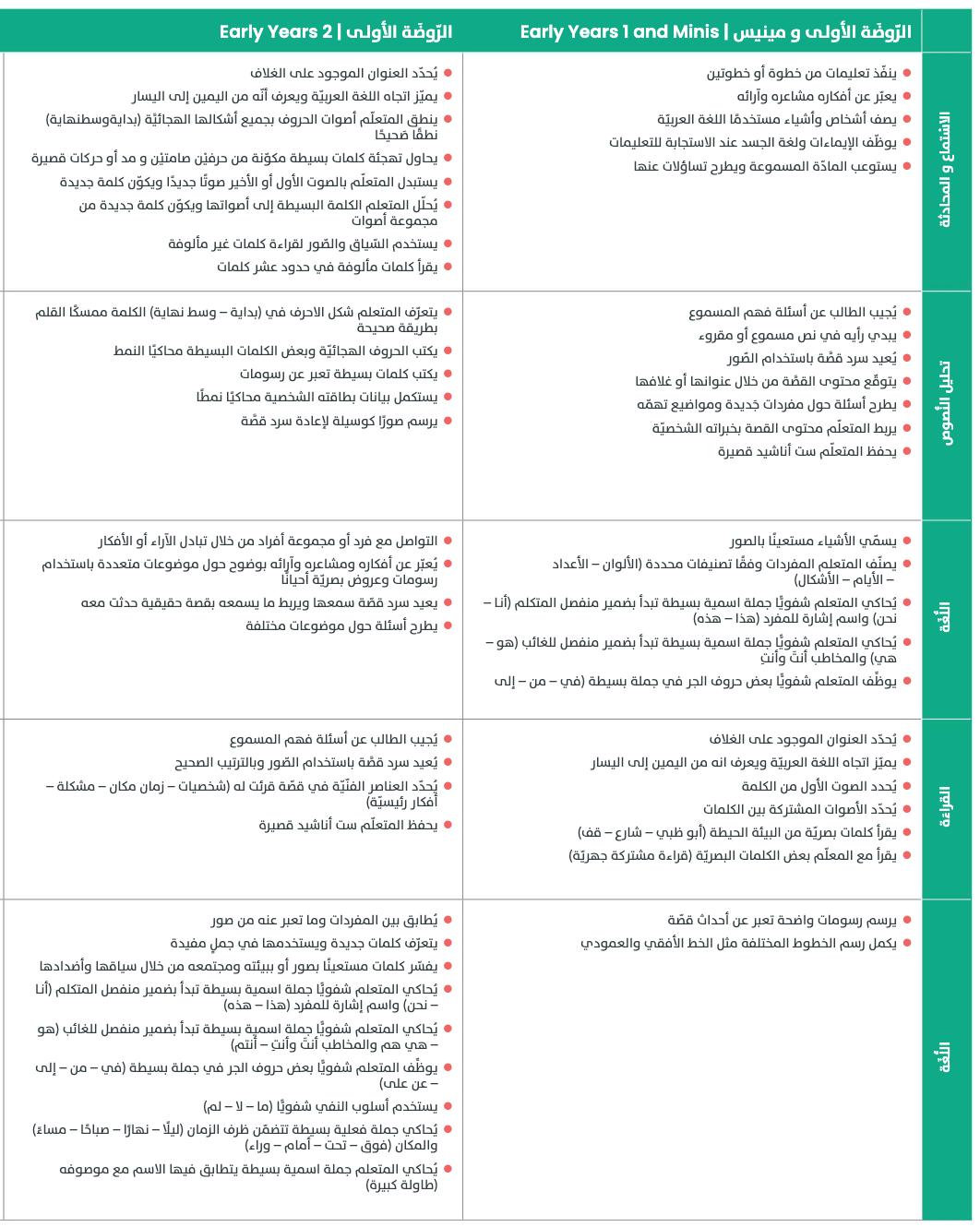

Recitethenumbersequenceforwardsandbackwardsfrom0–10
Understandthatthe astnumberreachedwhencountngasmall setofobjectstelsyouhowmanythereare ntotal(‘cardna prnciple’)
Countrelablyupto5objects
Understandconservationofnumber0–5
Recogniseandreadnumerals0–5
Relatenumeras0–5totheirrespectivequantities(matching numeralstosets)
Demonstrateanunderstandngof1-1correspondenceby matchingpairsorsetsofobjectsorpictures
Comparequantitiesusingthelanguage(morethan’and‘fewer than)
Usemark-makingtorepresentnumbersinplayactvitiesthatcan beinterpretedandexpained
Usethelanguageofordnalnumber(first second third,last)
AddtionandSubtraction
Understandandusetheconceptsof‘onemore’and one ess’ n playsituations
Usecountngtosolvesmpemathematicsprobemsineveryday andplaysituatons
Copyarangeofsimplepatternsandsequencesvisuallyand auraly
Sortandmatchsetsofobjectsbyrecognisingsimilarites
Rectethenumbersequenceupto20 forwardsandbackwardsandfromdifferent startingpoints
Countreliablyupto20objects demonstratingunderstandingof1-1correspondence andthecardnalprincple
Understandconservationofnumber
Readnumbersinfigures0-20
Ordernumerals0-20
Comparequantitiesandnumberswithin20 identifyingwhetheronequantityisgreater than lessthanorthesameastheotherquantity
Writenumbersinfigures0–10
Makeasensbleestimateofupto10objectsthatcanbecheckedbycountng
Subitiseupto5 recognsinggroupsofobjectsandreguarspatalpatternswithout counting
Useordina numbersto10indalyactivtiesandpay
AdditionandSubtracton
Recall onemore and‘oneless thananumberwthn20
Recallnumberbondsto5(parsofnumbersthatmake2,3 4and5)
Relateadditontocombinng2groupsofobjectsandcountingalltheobjects
Relatesubtractiontotakngawayobectsandcountingwhatremains Begintousethelanguageinvolved naddingandsubtractng
Solvesimpleproblemsinapracticalsituatonthatinvolvesmpeadditionand subtractonupto5
Understand‘before’and‘after inreationtopatterns tmeandnumber
Recognse,recreateanddescribetwo-andthree-partpatterns, ncludingobject colour shape szeandclapped/soundpatterns
Recognseanddescribepatternsintheenvironment
Sortandclassifyrea objectsaccordingtooneattributeandbegintoexplainrationale
Representcategorcaldatausingconcretegraphsandrecordcolectonsusingmarks numbersorpictures
Interpretdatabycountingthenumberofobjectsineachcategory
Length,MassandCapacity
Uselanguagerelatngtomeasurement(bg/small more/ess, full/empty,heavy/ight long/short)
Solvesmpemeasurementproblemsinplay roleplayandreallifesituations(exporeswhichobjectisheavierandwhich containerholdsmore/lessinsandandwaterpay)
Time
Useandrespondtosimplelanguageassociatedwithtime(first, next,after, ater)
Followsimpevisua timetabesthatconveydailyroutines
Money
Recognisethatmoneyisusedfortradingandmode money transactions npay
PropertiesofShapes
Recogniseandusethenamesfor2Dshapeswithinplayactivities andtheenvronment(crcle,squareandtriangle)
Useandbuildwth2Dand3Dshapeswithinplay-basedactivities
PostionandDirecton
Understandandusethevocabularyofpositionanddirection
(over under,up down,on beside in, nfrontof,behnd forwards, backwards sdeways)
Length MassandCapacity
Usemathematica languagerelatingtomeasurement(longer/shorter; longest/shortest;heaver/lghter;heaviest/lghtest;holdsmore/hodsless holdsthe most/least;hot/cold)
Compareandordertwoormoreobjects ntermsoflength massorcapacitybydirect comparison
Exploreandusenon-standardunitstomeasureLength MassandCapacty
Time
Understandandusevocabularyrelatingtotime(before/after earlier/later, today/tomorrow,morning afternoon,evening,night)
Sequencefamliareventsorevents nastory
Rectethedaysoftheweeksinorder
Money
Useonedrhamconstomakedifferentamountswithintendirhams
PropertiesofShapes
Recognseandnamecommon2Dshapesandsome3Dshapes(crcle square triangle andrectangle cube,cuboid coneandsphere)withinplayactivitesandthe environment
Use2Dand3Dshapestomakemodelsandpictures
PositionandDirection
Understandandusethevocabularyofpositionanddirection(below above beneath between nextto inside,outside straight curved through around)
Countforwardsandbackwardswthn50fromdifferentstartngpoints
Readnumbers nfiguresfrom0to50
Writenumbers nfiguresfrom0to50,formingandorentatingthemcorrectly
Readandwritenumberwordsto10
Compareandordernumbersto50
Makeasensibleestimateofupto20obectsthatcanbecheckedbycounting
Demonstrateanunderstandngofplacevalueuptoat east20;ie,1tenand4onesmake14
AddtionandSubtracton
Recallpairsofnumbersthatmake10(7+3=10,4+6=10)
Recalldoublesofnumbersto10
Recalladditionfactsfornumbersupto10
Identify‘onemore’(+1)and one ess’(-1)thananumberwithin50
Addandsubtractapairofsingle-digtnumbers
Addorsubtractasingle-digitnumbertoorfrom10
Understandandusemathematicaltermsforadditonandsubtracton(add plus,altogether sum morethan subtract mnus,takeaway,dfference)
Understandanddemonstratethecommutativepropertyofaddition
Solvesimpeprobemsinapracticalsituatonthatinvoveadditonandsubtractionwithin10 orknownfacts
PartsofaWhoe
Recognise,findandnameahalfas1of2equalpartsofanobject shapeorquantity
Extend createanddescribepatternsincolour shapes,sizeandnumber(2red 3blue)
Recogniseandcreatedifferentarraysofthesamenumber
Recogniseandunderstandoddandevennumbersto20
Sortandcassfyrea obectsaccordingtotwoattributesandexplanrationale
Representcategoricaldatausingpictographsandblockgraphs Interpretdatabycomparingquantites;usngcomparative anguageandnumbertodescribe andsummarisedata
Length,MassandCapacity
Compareandorderthreeormoreobjectsintermsof ength,massorcapacitybydirect comparisonormeasuring
Usenon-standarduntstomeasureLength,MassandCapacity
Measurelength nstandardunts(centmetres upto30cm)
Time
Usethevocabuaryoftimeandcalendarstodiscussandsequenceevents daysoftheweek, monthsoftheyearandseasons
Telthetimetothehourandhafpastthehouranddrawthehandsonaclockfacetoshow thesetmes
Money
Identifyandordernotesandcoins(UAEdirham)
PropertiesofShapes
Recognise,nameandbegntodescribethepropertiesofcommon2Dshapes(crcle,square trangeandrectangle)and3Dshapes(cube cuboid cone sphereandpyramd)usng mathematica vocabulary
Identify2-Dshapesonthesurfaceof3-Dshapes (forexample acirceonacylnderanda trangeonapyramid)
Recognisesymmetryintheenvironmentandcompleteasymmetricalpictureorsmpleshape PostionandDirecton
Giveandfolowsimpledirectionsreatedtopositionanddirection
Exploreandrespondtonaturalphenomenaintheirsetting
Makeobservationsanddrawpicturesofanimalsandplants
Participateinteacherguidedinvestigations
Explorecollectionsofmaterialswithsimilarand/ordifferent properties
Talkaboutwhattheysee,usingawdevocabulary
Throughcreativeplay,exploredifferentmaterialsandshare reasoningforselectingmaterialsfordifferentpurposes
Respondtoquestionsaboutfamiliarobjectsandevents
Shareobservationsandideas
Partcipateinteacherguided nvestigationsandexploreand makeobservationsbyusingthesenses
Groupandclassfyobectsusinggivencriteria
Describeorallywhatwasdoneandobserved
Identifyandnameavarietyofeverydaymaterials including wood plastic,glass metal,water androck
Describethesimplephysicalpropertiesofavarietyofeveryday materials.
Compareandgrouptogetheravarietyofeverydaymaterialson thebasisoftheirsimplephyscalproperties
Throughexploringpropertesandsourcesofmaterials,choose appropriatematerialstosolvepracticalchalenges
Describetheneedsoflvingthngs
Noticeanddescrbecharactersticsofthefivesenses
Groupandstatethefivesensesusingvisibleoridentifiable concreteattributes
Distinguishbetweenlvingandnon-livngthings
Sortlivingthingsintogroupsandexplainmydecisions
Helptogrowplantsandnametheirbasicparts Talkabout howtheygrowandhowtolookafterthem
Identifyandnameavarietyofcommonwildandgardenplants includingdecduousandevergreentrees
Identifyanddescribethebasicstructureofavarietyofcommon flowerngplants includingtrees
Helptodesignexperimentstofindoutwhatplantsneedinorder togrowanddevelop
ObserveandrecordmyfindingsandwhatIhavelearnt.
Askquestionsthatinquireaboutthewordaroundhim/her
Observeandmanipulateobjectsbyusingallsensesasapproprate
Recognseaproblemtoinvestigateandparticipatesinguidedinvestigations
Useavarietyof nstrumentsandtoolstogroupandclassifyobjectsusinggvencritera
Describeorallyhowdatawasgatheredandwhatpatternswereobserved
Observeanddescribeseasonalattributesandchanges
Investigatehowwatercanchangefromoneformtoanother relatemyfndingstoeverydayexperiences
Observethevastnessofthesky recognisingthesun,moonand starsandlnkthemtodailypatternsoflife
Investigatefoatingandsinkingofobjectsinwater
Applytheunderstandingofbuoyancytosolveapractical challenge(heavyandlight)
Throughpay,exploreavaretyofwaysofmakingsounds
Noticethatanimals includinghumans,haveoffspringwhchgrow ntoadults
Findoutaboutanddescribethebasicneedsofanimals,includnghumans forsurvival (water foodandair)
Describetheimportanceforhumansofexercise eatingtherghtamountsofdifferenttypes offood,andhygiene
Identifyandnameavarietyofcommonanimalsincludngfish,amphibians,reptiles,birds andmammals
Identifyandnameavarietyofcommonanimalsthatarecarnivores,herbivores and omnivores
Exploreexampesoffoodchainsandshowanappreciationofhowanimalsandplants dependoneachotherforfood
Observechangesacrossthefourseasons
Observeanddescribeweatherassociatedwiththeseasonsandhowdaylengthvaries
Througheverydayexperiencesandpaywithavarietyoftoysandotherobjects recognise simpletypesofforcesanddescribetheireffects.
Performlocomotorskils(hopping,galloping,running sliding,skipping)whilemaintainingbalance
Travel ngeneralspacewthdifferentspeeds
Followdirectionsingroupsettings(eg safebehaviors followingrules,takingturns)
Followinstruction/directionswhenprompted
Shareequpmentandspacewithothers
Enjoyinteracting,playingandengagingwithothers
Understandthattaketurnshepusworktowardsagoal
Performjumpingandlandingactionswithbalance
Maintanmomentarystillnessondifferentbasesofsupport
Formwide narrow curedandtwistedbodyshapes
Rollsidewaysinanarrowbodyshape
Dropsaballandcatches tbefore tbouncestwice
Dribbleaballwithonehand attemptingthesecondcontact
Travelin3differentpathways
Sharesequipmentandspacewthothers
Listenrespectfullytoothers
Reachoutforhelpwhenitisneededforthemsevesorothers
Identifywhenactionshaveimpactedonothers
Understandthatexperiencesdependoncooperationofgroupmembers
Demonstrateanawarenessofbasichygeneintheir daiyroutines
Understandthatinordertoplaysafelyspaceshouldbe andrulesfollowed
Identifythemselvesinrelatontoothers(forexample, family,peers,schoolclass,ethnicity,gender)
Understandthataspeoplegrowandchange,they developnewsklls,understandingsandabilities
Developarangeoffineandgrossmotorsklls
Explorecreativemovementsinresponsetodifferentstimul
Observechangesinbodiesduringexercise
Describesimilaritiesanddifferencesbetweenthemselvesandothers
Developindependencebuidssef-worthandpersonalresponsiblity
Throwunderhandwithoppositefootforward
Dropaballandcatchesitbeforeitbouncestwice
Catchalargebaltossedbyaskilledthrower
Dribbleaballwithonehand,attemptingthesecondcontact
Differentiatebetweenmovementinpersonal(self-space)andgeneralspace
Moveinpersonalspacetoarhythm
Vaueinteracting,playingandlearningwithothers
Cooperatewithothers
Understandthatactionstowardsothersinfluencetheiractionstowardsus
Useandadaptbasicmovementskills(grossandfinemotor)inavarietyofactivities
Displaycreativemovementsinresponsetostimuliandexpressdifferentfeeings emotionsandideas
Understandtheneedtoactresponsiblytohelpensurethesafetyofthemselvesand others
Explainhowdfferentexperiencescanresult ndifferentemotions
Identifyfeelingsandbegintounderstandhowthesearerelatedtobehaviour
Solveproblemsandovercomedifficultieswithasenseofoptimism
Identifyandunderstandtheconsequencesofactionsareawareoftheiremotionsand begintoregulatetheiremotona responsesandbehaviour
Understandthatchallengesandsituationsrequredifferentstrategies
Colour:Choosecolourstobeusedinanartwork
Colour:Explorehowcolourscanbechangedbymixing paint
Line Understandthatclosinglineswillmakeashape
Shape Identifyshapesinanartwork
Texture:Exporemarkinganddrawingondfferent surfaces,suchascardboard,paper whiteboards etc
Tone Understandsthatpencilsandpenscanmake marksonasurface
Colour:Identifycoloursusedinanartwork
Colour:Knowthatcolourscanbelight bright,ordark
Form:Handle,feelandmanipuateclaytocreate3Dartwork
Line: Describelinesusingvocabulary:long,short,thck,thin,straight curved
Shape:Representfeaturesandformsofpeopleusingsimpleshapes whendrawing
Texture Exploretexturethroughrubbings suchasleaves,coins, sandpaper,etc
Texture Discovertherelatonshipbetweenhowthingsfeelandhow theyarerepresented nart,suchasfluffy furry smooth,rough etc
Tone:Uselightanddarkcoloursinartpurposefully
Experimentwithcoours,linesandshapesusingselected materals
Participateinartactivitiesthatencourageselfexpressionandcommunicatonofideas
Discusswhattheyhavecreatedintheirartwork
Sharepersonalfeelingsaboutart
Discussfamousartworksanddiscussobservationssuch coours,shapes,etc
Explore view andcreate2Dand3Dartworks(drawings paintngs collages,claysculptures,etc)
Createartworkfromselectedmaterials,describingchoicesmade
Discusstheprocessandmaterialsusedincreatingtheirartwork
Observeanddiscussartworkcreatedbyvarousartists,focusingon colours texture,lines,andtheme(nature city,people,etc)
Colour Knowtheprimarycolours
Form:Changepaperfrom2Dto3Dbyfolding rolling andscrunchingit
Form:Understandthedifferencesbetweentwo-dimensionalandthree-dmensionalart
Lne:Usedrawingtoolsinavarietyofwaystocreatedifferentlines
Lne:Representmovementindrawingsusinglines
Shape:Cutandfoldpapertochangeshapes
Shape:Createpatternsusingshapes
Pattern:Understandthatapatternisadesigninwhchshapes,cooursorlinesare repeated
Texture:Understandthattexturemeans‘whatsomethingfees ike’
Texture:Representthetextureofobjectsusingdifferentmarks
Tone:Addtonetoadrawingbyshadingandfillingashape
Identify planandmakespecificchoiceswhencreatingartworks (materias,tools skills andprocesses)
Makepredictions,experiment andantcipatepossibleoutcomes
Applyskillswithtoolstocreateartworkwithincreasingcontro (scissors brushes drawingtools)
Describeandcomparesimilaritiesanddifferencesbetweenartworks
Analyseother’sartworkandapplyobservatonstotheirownartwork
Melody Identifythatsoundsmaybehighandlow
Rhythm Respondtoasteadybeat(Throughsinging, movementandplaynginstruments)
ReadingandWriting Playrhythmsusingbody percussion,instrumentsorspokenwords(Through echoingorreadingwrittennotation)
Singing Distinguishbetweenspeakingandsinging voices
Singing Respondtotonematchingandechogames (throughmovement singingorinstrumentplaying)
Expression:Performsimpeactionsongsandsingng games
Melody Identifythatsoundsmaybefastandsloworloudorsoft
Rhythm Identifythatmuscismadeupfromdifferentsounds(long sounds,shortsoundsandsilences)
ReadingandWritng Begintorecognisesimplerhythmicpatterns
Singng Respondtotonematchingandechogamesinunisonthrough movement,singing,andinstrumentplaying
Expresson:Describehowmusichelpstoexpressfeelings
Expresson:Identifythatdfferentinstrumentshavedifferenttona qualities(includingthehumanvoice)
Improvisemovementtomusicalelements(high-low loud-soft,shortlong sow-fast)
Takeresponsibilityforthecareoftools materialsandresources
Harmony: dentifythattwoormoresoundscanoccursimutaneouslytocreateharmony
Melody:Identifythatsoundsmaybehigh lowor nthemiddle
Form:Categorisemusicintosections(eg aikeanddifferent,fastandslow loudand soft highandlow)
Expression Showthatthebeatinmusiccanchange(fastorslow=tempoorsoft(p) andloud(f)=dynamics)
Rhythm:Demonstratethatlongsounds,shortsounds andsiencesmaybegroupedto formrhythmpatterns(throughtraditionalornon-traditionalwrittennotationand performedmethods)
Readingandwriting Identifyandperformquarterandeghthnotepatterns
Singing:Performrhythmicandmelodicsongsinunisonandintune(throughgamesand actionsongs)
Participateinavarietyofcreativeexperiences Createaperformance nspiredbypersonalexperiences Communicateideas feelingsand/orexperencesthroughcombiningavarietyof elements
Communcateaninitialresponsetoanartworkusnga varietyofmethods(eg vsual oral,orphysical)
Describeanartworkbystartingtousesubjectspecificlanguage (materials,skilsandprocesses)
Makeconnectionstoartworksbyexpressngandjustifyngopinionsusingsubject specificlanguage

